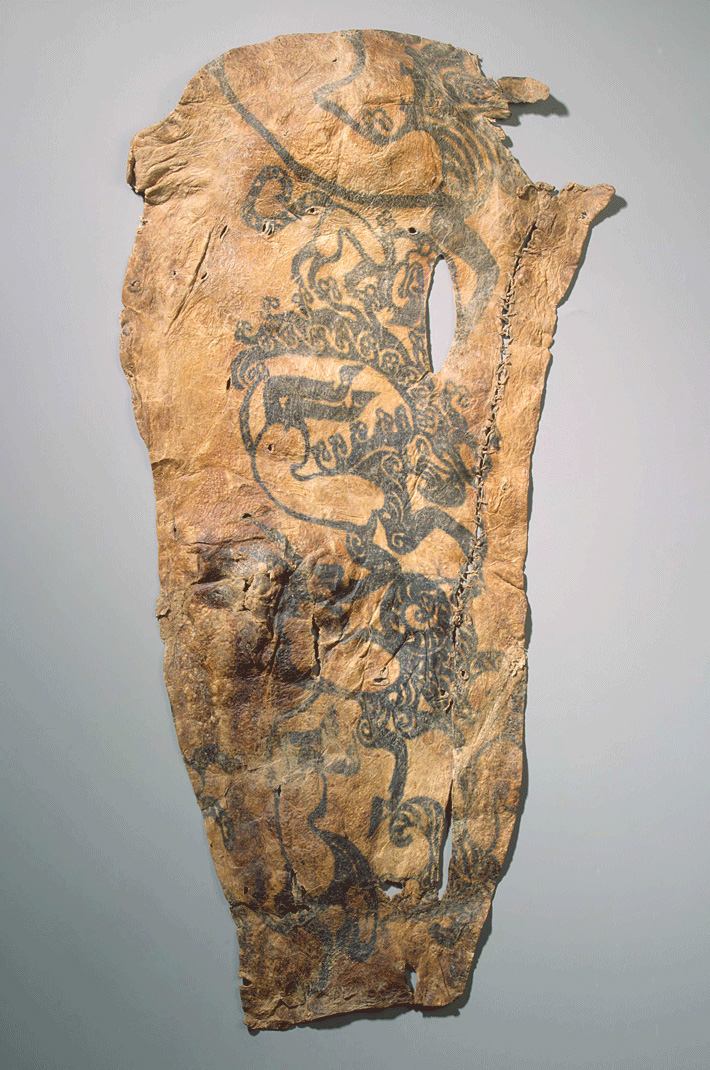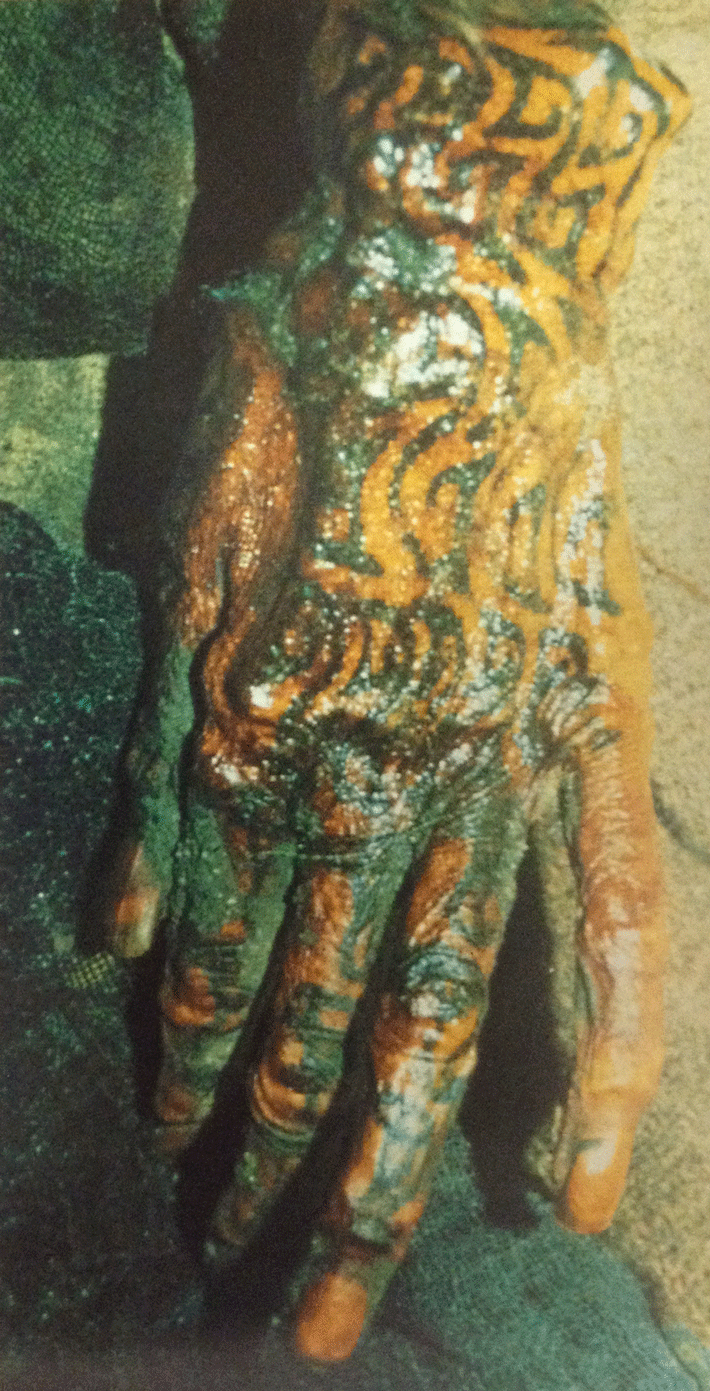Ancient Tattoos
Iron Age Mummy
Wednesday, October 09, 2013
 Some of the most spectacular tattoos in the ancient world have been found adorning Iron Age mummies unearthed in the Altay Mountains of Siberia. There, a series of tombs dug into permafrost preserved the remains of nobles from a nomadic people today known as the Pazyryk Culture. On the skins of these mummies were intricate tattoos, depicting both mythical and real animals in action: running, stalking victims, or twisting in an S-shape, which scholars call “the pose of agony.”
Some of the most spectacular tattoos in the ancient world have been found adorning Iron Age mummies unearthed in the Altay Mountains of Siberia. There, a series of tombs dug into permafrost preserved the remains of nobles from a nomadic people today known as the Pazyryk Culture. On the skins of these mummies were intricate tattoos, depicting both mythical and real animals in action: running, stalking victims, or twisting in an S-shape, which scholars call “the pose of agony.”
Archaeologist Sergey Yatsenko of the Russian State University for the Humanities says the animal most commonly found was a monster that took the form of a wild goat with an eagle’s beak and a panther’s tail. This creature appeared on the upper part of the right shoulder of most of the mummies. On the left shoulder, the Pazyryk people sported the depiction of a tiger or a wild ram. A rooster poised for battle was frequently tattooed on noblemen’s forefingers, and a group of goats or rams often marched along their lower legs.
Yatsenko points out that Greek accounts of the period stress that “barbarians” in Eurasia never went nude or even semi-nude in public, so most of these tattoos would probably have never been seen by others. Why endure the long and painful process of getting such dramatic tattoos if they were always covered? “I think they were for magical protection,” says Yatsenko, whose favorite Pazyryk tattoos are abstract designs found on the hands of a man who was probably a shaman. “Those tattoos were probably his spiritual weapons.”
Tarim Basin Mummy
Friday, October 11, 2013
 The barren desert of China’s southern Tarim Basin has been the source of some of the ancient world’s most mysterious tattooed mummies. One of them belonged to a woman who some time between 1000 and 600 B.C. was possibly sacrificed and then buried in a necropolis now outside the modern village of Zaghunluq. The woman had brown hair with white streaks that had been braided and tied with red wool string, and her eyebrows had been painted just before her death.
The barren desert of China’s southern Tarim Basin has been the source of some of the ancient world’s most mysterious tattooed mummies. One of them belonged to a woman who some time between 1000 and 600 B.C. was possibly sacrificed and then buried in a necropolis now outside the modern village of Zaghunluq. The woman had brown hair with white streaks that had been braided and tied with red wool string, and her eyebrows had been painted just before her death.
University of Pennsylvania scholar Victor Mair has worked in the Tarim Basin and has studied the mummies for more than 30 years. He believes the woman’s charcoal and soot tattoos were likely ornamental or symbolic. They include moons on her eyelids, ovals on her forehead, and a decorative scroll pattern on her left hand, wrist, and exceptionally long fingers. Although the culture to which the woman belonged has not been identified, the similarity of her tattoos to those of other mummies from Russia, for example, clearly identifies her as part of the Eurasian tradition of tattooing that begins with Ötzi some 5,000 years ago.
Advertisement
Advertisement
IN THIS ISSUE
Advertisement

Recent Issues
-
 May/June 2024
May/June 2024
-
 March/April 2024
March/April 2024
-
 January/February 2024
January/February 2024
-
 November/December 2023
November/December 2023
-
 September/October 2023
September/October 2023
-
 July/August 2023
July/August 2023
-
 May/June 2023
May/June 2023
-
 March/April 2023
March/April 2023
-
 January/February 2023
January/February 2023
-
 November/December 2022
November/December 2022
-
 September/October 2022
September/October 2022
-
 July/August 2022
July/August 2022
-
 May/June 2022
May/June 2022
-
 March/April 2022
March/April 2022
-
 January/February 2022
January/February 2022
-
 November/December 2021
November/December 2021
-
 September/October 2021
September/October 2021
-
 July/August 2021
July/August 2021
-
 May/June 2021
May/June 2021
-
 March/April 2021
March/April 2021
-
 January/February 2021
January/February 2021
-
 November/December 2020
November/December 2020
-
 September/October 2020
September/October 2020
-
 July/August 2020
July/August 2020
-
 May/June 2020
May/June 2020
-
 March/April 2020
March/April 2020
-
 January/February 2020
January/February 2020
-
 November/December 2019
November/December 2019
-
 September/October 2019
September/October 2019
-
 July/August 2019
July/August 2019
-
 May/June 2019
May/June 2019
-
 March/April 2019
March/April 2019
-
 January/February 2019
January/February 2019
-
 November/December 2018
November/December 2018
-
 September/October 2018
September/October 2018
-
 July/August 2018
July/August 2018
-
 May/June 2018
May/June 2018
-
 March/April 2018
March/April 2018
-
 January/February 2018
January/February 2018
-
 November/December 2017
November/December 2017
-
 September/October 2017
September/October 2017
-
 July/August 2017
July/August 2017
-
 May/June 2017
May/June 2017
-
 March/April 2017
March/April 2017
-
 January/February 2017
January/February 2017
-
 November/December 2016
November/December 2016
-
 September/October 2016
September/October 2016
-
 July/August 2016
July/August 2016
-
 May/June 2016
May/June 2016
-
 March/April 2016
March/April 2016
-
 January/February 2016
January/February 2016
-
 November/December 2015
November/December 2015
-
 September/October 2015
September/October 2015
-
 July/August 2015
July/August 2015
-
 May/June 2015
May/June 2015
-
 March/April 2015
March/April 2015
-
 January/February 2015
January/February 2015
-
 November/December 2014
November/December 2014
-
 September/October 2014
September/October 2014
-
 July/August 2014
July/August 2014
-
 May/June 2014
May/June 2014
-
 March/April 2014
March/April 2014
-
 January/February 2014
January/February 2014
-
 November/December 2013
November/December 2013
-
 September/October 2013
September/October 2013
-
 July/August 2013
July/August 2013
-
 May/June 2013
May/June 2013
-
 March/April 2013
March/April 2013
-
 January/February 2013
January/February 2013
-
 November/December 2012
November/December 2012
-
 September/October 2012
September/October 2012
-
 July/August 2012
July/August 2012
-
 May/June 2012
May/June 2012
-
 March/April 2012
March/April 2012
-
 January/February 2012
January/February 2012
-
 November/December 2011
November/December 2011
-
 September/October 2011
September/October 2011
-
 July/August 2011
July/August 2011
-
 May/June 2011
May/June 2011
-
 March/April 2011
March/April 2011
-
 January/February 2011
January/February 2011
Advertisement






